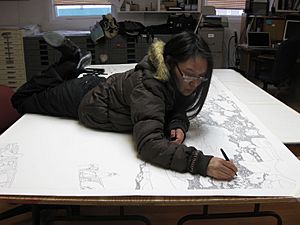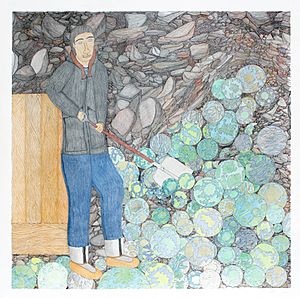Shuvinai Ashoona facts for kids
Quick facts for kids
Shuvinai Ashoona
ᓱᕕᓂ ᐊᓱᓇ |
|
|---|---|
 |
|
| Born | August 1961 (age 64) |
| Known for | Draughtperson, graphic artist |
| Awards | Gershon Iskowitz Prize (2018) |
Shuvinai Ashoona RCA (Inuktitut: ᓱᕕᓂ ᐊᓱᓇ, born in August 1961) is an Inuk artist. She mainly creates drawings. She is well-known for her detailed pen and pencil drawings. These artworks show northern landscapes and modern Inuit life.
About Shuvinai Ashoona
Shuvinai Ashoona was born in 1961 in Kinngait, which was then called Cape Dorset. This area is now part of Nunavut. She comes from a family of very talented artists. Her father, Kiugak Ashoona, was a sculptor. Her mother, Sorosilooto Ashoona, was a graphic artist. Her grandmother, Pitseolak Ashoona, was one of the most famous Inuit artists of her time.
Shuvinai is also related to other artists. Her aunt, Napachie Pootoogook, and her cousin, Annie Pootoogook, were also artists. Shuvinai, Annie, and others were chosen to be part of a big art show in 2012. It was called Oh, Canada and took place at the Massachusetts Museum of Contemporary Art.
Shuvinai went to high school in Iqaluit. But she soon returned to the Kinngait area with her daughter. They lived in small communities like Luna Bay and Kangiqsualujjuaq. These experiences helped her create detailed drawings of the Inuit lands. In the late 1980s, her family moved back to Kinngait. Shuvinai then started visiting Kinngait Studios. There, her art style was shaped by her aunts and other artists like Kenojuak Ashevak.
Her Art Career

Shuvinai Ashoona's drawings sometimes show real nature. Other times, they come from her imagination. Her art often creates a busy, detailed look on the paper. She often draws egg shapes, the kudlik (a stone oil lamp), and the ulu (a traditional knife). Sometimes, she includes historical things or events. For example, she has drawn the Nascopie, a supply ship that sank in 1947. What makes Shuvinai's art special is how it shows a mix of old traditions and modern life in Nunavut.
Her first drawings in the Kinngait Studios archives are from around 1993. Kinngait Studios is a famous printmaking studio. Her early works were small, detailed landscape drawings. They were often in one color, showing rocky lands from above. These drawings were very detailed and intricate. They used ink and black fineliner pens. These landscapes were partly real, showing places around Kinngait. But they were also partly fantasy, with things like stairs that looked like land but led nowhere. Unlike other Kinngait artists, her landscapes often did not show people. They seemed to show her inner thoughts while also showing the outside world.
Because her drawing process was so careful, it took several years to create enough art for a show. In 1997, two of her small etchings were in the Cape Dorset print collection. Her first big art show was in 1999. It was called Three Women, Three Generations: Drawings by Pitseolak Ashoona, Napatchie Pootoogook and Shuvinai Ashoona. One of her works from this time, Rock Landscape, was shown on CBC Radio in 2003.
In the early 2000s, she started using color in her drawings. She began to show people, their homes, and tools within big, striking landscapes. An example is her work Composition (Sewage Truck) from 2007–2008. This piece is in the collection of the Art Gallery of Ontario. Over time, her art has shown more of her inner world. Eggs, card symbols, globes, and bits of text appear again and again.
She also worked with artist John Noestheden on a huge banner called Earth and Sky. This banner was first shown at Art Basel in 2009. It was also displayed at the 2012 Biennale of Sydney. Later, it was shown at the Justina M. Barnicke Gallery at the University of Toronto. There, it was shown with art by Toronto artist Shary Boyle. Boyle and Ashoona then worked together on a traveling show in 2015 called Universal Cobra. They created fantasy worlds together, sharing space on the paper.
Around 2009, Shuvinai Ashoona started drawing "worlds." She drew people, animals, and mixed figures interacting with blue and green planets. These were set in amazing, imaginary places. This work was shown in her exhibition Shuvinai's World(s) in Toronto in September 2012. She has often shown her art at Feheley Fine Arts in Toronto and Marion Scott Gallery in Vancouver.
In 2019, an exhibition called Mapping Worlds was organized by The Power Plant in Toronto. This was her first major solo museum show. Mapping Worlds continued to travel in 2020. It was shown at Concordia University in Montréal and at the Vancouver Art Gallery. Outside of Canada, an exhibition of her less-known work, Holding on to Universes, was shown in 2020 at the Glasgow Centre for Contemporary Arts in Scotland.
Shuvinai Ashoona is the subject of a short film called Ghost Noise (2010). It was directed by Marcia Connolly. The musician Kevin Hearn dedicated his song "Midnight Sun" to her. She even painted a guitar for him.
In 2018, Ashoona received the Gershon Iskowitz Prize. This award recognized her amazing contributions to visual arts in Canada. In 2024, she was also given a Governor General's Awards in Visual and Media Arts.
See also
 In Spanish: Shuvinai Ashoona para niños
In Spanish: Shuvinai Ashoona para niños

